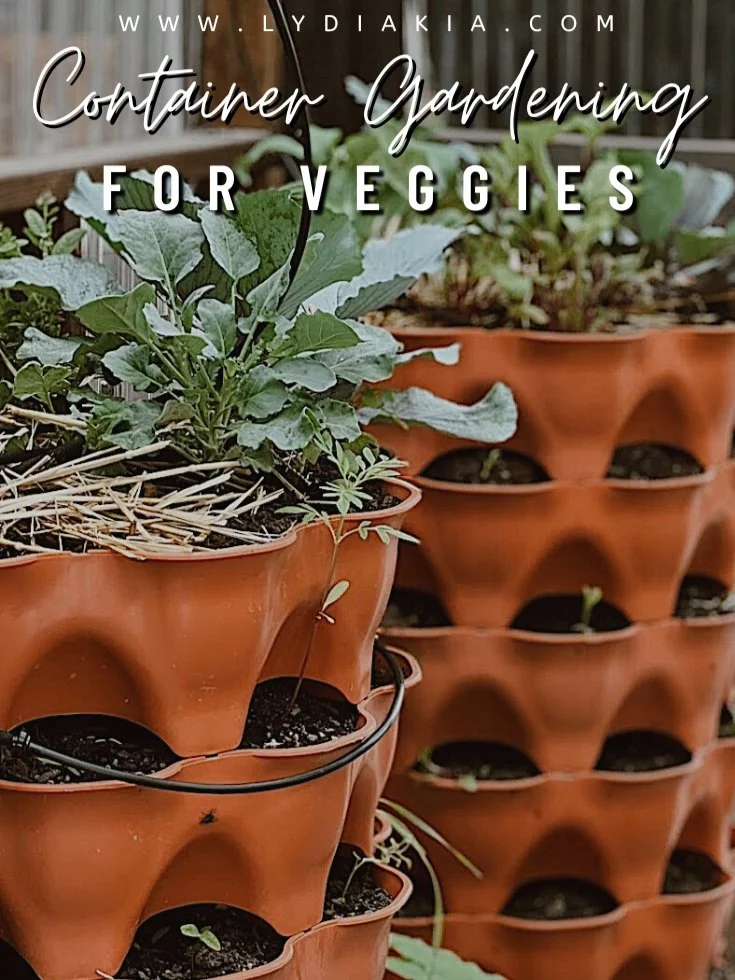Container Gardening for Veggies
Container gardening is a perfect idea for growing veggies if you don’t have a lot of outdoor space, or want a little more control over your plants. Whatever your reasons, containers are a great way to not only reduce your waste, but also have a sustainable way to eat! If you’re ready to start container gardening for veggies, keep reading for some helpful tips, and some great plants to start with…
Best Containers to Use
Planters are a great option if you want your containers to be cute and uniform. However, you can also utilize containers like buckets, milk jugs, juice containers, and even canvas bags. Almost anything that can hold soil can be a great planting container. However, when using plastic containers, make sure that they are food grade so you can avoid harmful chemicals from leaching into your soil and veggies. A good rule of thumb to keep in mind is that if food was already stored in it, it’s probably food safe as long as it wasn’t used to store chemicals.
Size is also important to consider when you’re choosing containers to plant in. You will want to find out how deep your root systems will be, as well as how wide they will spread. The height and width of your containers can be the difference between healthy, strong plants, and malnourished, rootbound plants. Most vegetables that will thrive in a container garden will have roots about 8 to 12 inches deep. Keep in mind that the smaller your containers are for your plants, the more you’ll need to water and fertilize the soil. Now, speaking of soil…
Soil for Container Gardening
Organic potting soil is perfect for growing veggies in containers, so you can choose your favorite brand, or even do some research for what soils are best for the plants you want to grow. However, soil isn’t all you need to have in your containers in some cases.
If your containers are too deep, (between 24 & 36 inches) you can add some materials to the bottom third to help with nutrients and drainage. Dry, organic materials are perfect for this. Dead leaves, straw, sticks, untreated cardboard/paper bits, etc. will help with drainage, and also break down over time to make more soil.
On the other hand, if your containers are shallower, (less than 24 inches) adding in that same organic material can start to steal nutrients like nitrogen from the soil. You don’t want this to happen, so instead, you can add food safe plastic bottles to the bottom third to boost the plants up and add drainage. Now that your containers are ready, it’s time to plant your veggies!
Best Vegetables for Container Gardens
(Always be sure to plant your seeds vertically, water well after planting, and label them!)
Corn
Stowell’s Evergreen Corn is a perfect variety for container gardening. The best containers for corn are shallow, wide ones. Mini raised beds are a wonderful option since corn is pollinated by the wind. Beds will allow you to plant your corn in groups so the wind can pollinate them better than in just a single row. Plant 2 seeds at a time with each pair being 8 inches apart, about 1.5 inches deep into the soil.
Cucumbers
If you can find small space bush varieties of cucumbers, they will thrive in containers that are about 5 gallons in size. You can plant 2 seedlings next to each other, and soon you’ll have yummy, refreshing cucumbers to eat!
Loofah
If you have a very large container you’re not sure what to do with, loofah is a great climbing plant. You can make a small “teepee” out of 3 dried bamboo shoots, and have 2 loofah plants growing from seedlings. (To make your teepee, stick each bamboo shoot about 6 inches into the soil at about a third of the way around, and tie together at the tops.)
Peppers
Peppers of all kinds thrive in warm weather, and are the perfect size for 3 gallon containers. Just be sure to move them inside at nights if temperatures go below the 60s.
Perennial Herbs
Perennial herbs like lavender, marjoram, oregano, parsley, peppermint, and sage can grow very well in containers, but they can also be prone to becoming root bound. When this happens, you will need to remove them from their containers and gently break them up into smaller plants and replant separately. (Never plant mint plants in the ground unless you want them to take over!)
Potatoes, Sweet Potatoes, & San Marzano Tomatoes
These three veggies are all very similar in how they grow, and the size of containers that they need.
All of these are perfect if you have a lot of very large containers that are over 5 gallons. You can also take advantage of how they grow by planting them deep down in your containers, and slowly adding soil as the stems get taller. Wherever the nodes of their stems touch soil, they will grow roots, and increase your yield!
Runner Beans
Another teepee lover is the Blauhilde runner bean. Not only is this bean beautiful, but it grows really well in large containers with room to climb. When planting, be sure to plant 2 seeds next to each climbing pole at about an inch deep.
Zucchini & Crookneck Yellow Squash
Both of these veggies thrive in 5 gallon sized containers, and have a great yield. Plant two seeds at a time about an inch deep, and soon you will have delicious squash and zucchini just in time for fall soups and stews.
I hope you are inspired to try container gardening for veggies! Let me know in the comments below if you have any awesome ideas for containers, or even some tips you’ve learned from container gardening on your own!
LOVE THIS STUFF? Get my free self care guide







